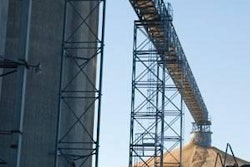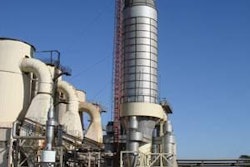Pressure from big consumer retailers, particularly Wal-Mart, is pushing radio frequency identification (RFID) technology upstream to suppliers. Sources estimate that Wal-Mart alone, as the world's largest retailer, requires about 1 billion RFID tags, mainly on pallets of consumer goods shipped by suppliers into retail locations worldwide. The global retailer's attraction to RFID technology mostly relates to inventory management--improving just-in-time-delivery' of stock to prevent 'stock-out' problems which send impatient consumers to other stores.
The advance in inventory management is good for suppliers, too, and they are taking advantage of lower costs as the RFID industry rapidly expands to meet retailers' needs. A recent DePaul University study, sponsored by Chicago-based market research firm USA Strategies, describes the rapid decline in the cost of RFID chips and the corresponding rise in intranet and web-based systems relying on data from RFID tags (see http://www.usachicago.com/news releases/yanahan_press5_2.pdf and http://www.packworld.com/cds_search.html?rec_id=19354&eclip=yes). North America's grain industry, too, is taking advantage of the lower cost of RFID tags and the increased data management power and flexibility of RFID-based systems.
At the GEAPS Exchange in Nashville, Tennessee, earlier this year, CompuWeigh Corporation's CEO Robin Sax told FEED MANAGEMENT that only two years ago RFID chip-carrying tags or cards for use in grain trucks cost $35 each. Now, the unit cost has come down to about $1 and still is declining. Along with the lower cost of RFID tags, there has been a corresponding increase in grain industry applications. Sax explained how RFID technology generated large cost savings, improved security of facilities and grain in transit and storage, and accelerated expansion of 'identity preserved' IP grain and oilseed markets. See http://www.compuweigh.com/.
Sax also pointed out that feed manufacturers can use the new technology profitably, too, for similar applications as the grain industry. Moreover, feed makers also can use RFID-based systems to meet certain special feed and food safety requirements, such as improved upstream traceability of feedstuffs and downstream trackability of feed products.
"We're actually in the second generation of RFID-based grain facility automation," Sax said. "We have added a lot of components to our system since 2004 when we introduced the technology at Agmark's rail terminal in Concordia, Kansas, and Commodity Resource Corporation's grain, feed, and fertilizer distribution center in Caledonia, New York. Now, for the first time, we can make the scale completely unattended."
For grain companies, saving labor at the scale generates significant immediate cost savings, which Sax says can reduce the payback period for a basic RFID-based truck management system to less than a year.
CompuWeigh uses readable and writable RFID tags--one tag per truck--is the most popular method of use at present. The tags use the new Wal-Mart Gen2 standard, which provides a 10-ft 'read range.' Each tag carries a unique identification number.
"There is no point in putting too much information on the tag," Sax says. "Just a unique ID number is embedded on the tag. All the relevant information associated with that unique number is on the facility's computer hard drives or a network server. With the RFID tag in the truck, when the truck passes an RFID reader, we know the 'history' of the truck."
In a typical facility, an incoming truck first arrives at the 'probe shack' where the grain is sampled and the truck management system's first RFID reader identifies the truck by its unique RFID tag. From that point, the system can track the truck wherever it goes at the facility, using a series of tag readers, electronic 'traffic eyes' for truck positioning on the scale, and fixed and moveable digital video cameras: Weigh-in at the unattended scale, discharge at multiple unattended dump pits, weigh-out at the scale and automatic print-out of delivery ticket, and exit from the facility.
In this basic application of RFID technology, Sax says, the tag represents the truck, which is fulfilling the grain delivery contract. However, with the lower cost of RFID chips, multiple RFID tags are being issued for each contract to the farmer. This approach makes the tag specific to the actual load of grain, not the truck. Sometimes the farmer might use his own truck and other times he might contract delivery. In either case, the RFID tag would apply to the specific load.
The current, upgraded system features other innovations, Sax says:
-
An outside display screen manages the driver through the process, providing the driver with weight and grade information as well as prompts for the driver's next action;
-
An outside ticket printer allows the driver to stay in his truck;
-
The capability exists for an electronic signature unit, so that the weighmaster's signature can appear on the delivery ticket.
Sax notes that the RFID-based grain delivery system enables a more automated grain inventory system: "Using the RFID tag and prompts from the outside displays, the driver can deliver to the correct dump pit so that the grain is sent to a specific bin. This provides the foundation for an identity 'preservation' system that tracks the grain all the way through the process."
"Because of the traceability potential, the IP grain systems of the future will rely on this type of technology," Sax says. "Eventually, a receiving terminal in Japan could know all the fields in America which grew the grain just delivered. Likewise, a feed manufacturer here or abroad could trace back a specific load of a commodity ingredient.
"So there are numerous feed and food safety applications. But lowering costs still generates the most interest at present. With an add-on RFID mapping system, the technology can answer questions like, 'Where are my rail cars right now?' without relying on a slow answer from the railroad.
"So far though," Sax adds, "feed mills are not yet pushing RFID technology that hard. What may increase interest short-term are the new security rules that prevail under the federal Bio-Terrorism Act. An RFID-based system can include video cameras that not only show live pictures but are programmed to record a picture of the truck to disk that can be reviewed if there is ever a problem."





.jpg?auto=format%2Ccompress&fit=crop&h=167&q=70&w=250)











